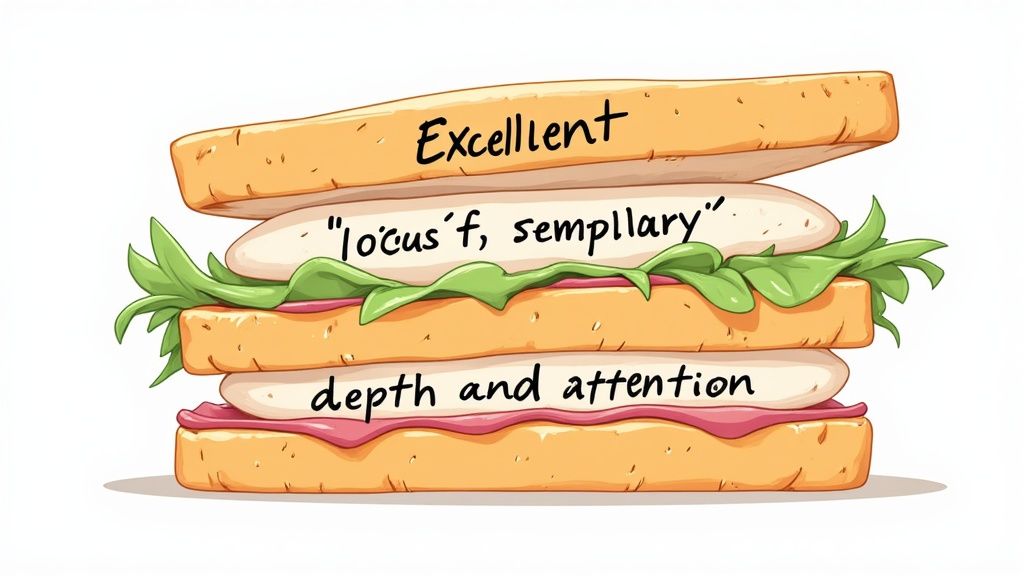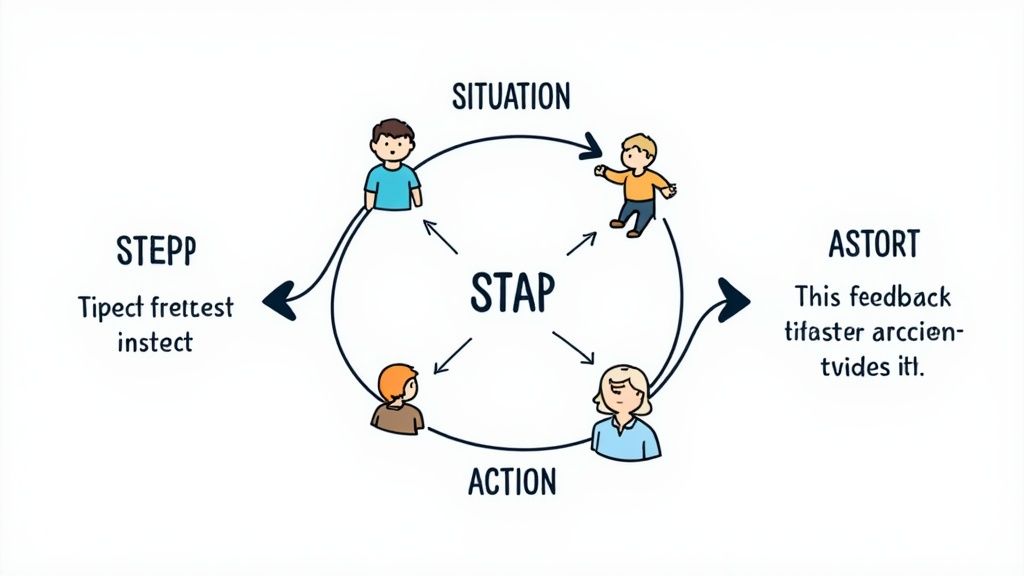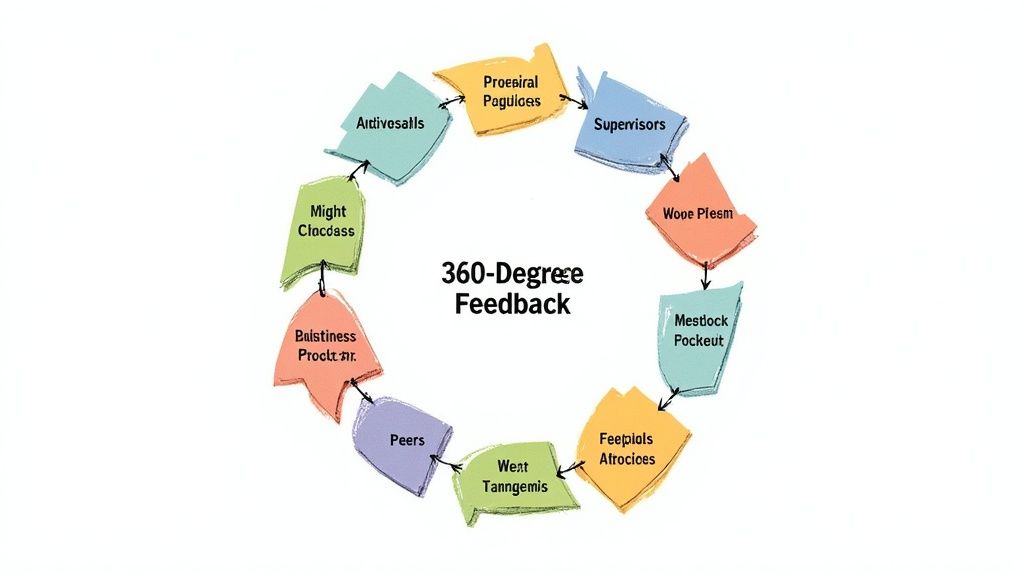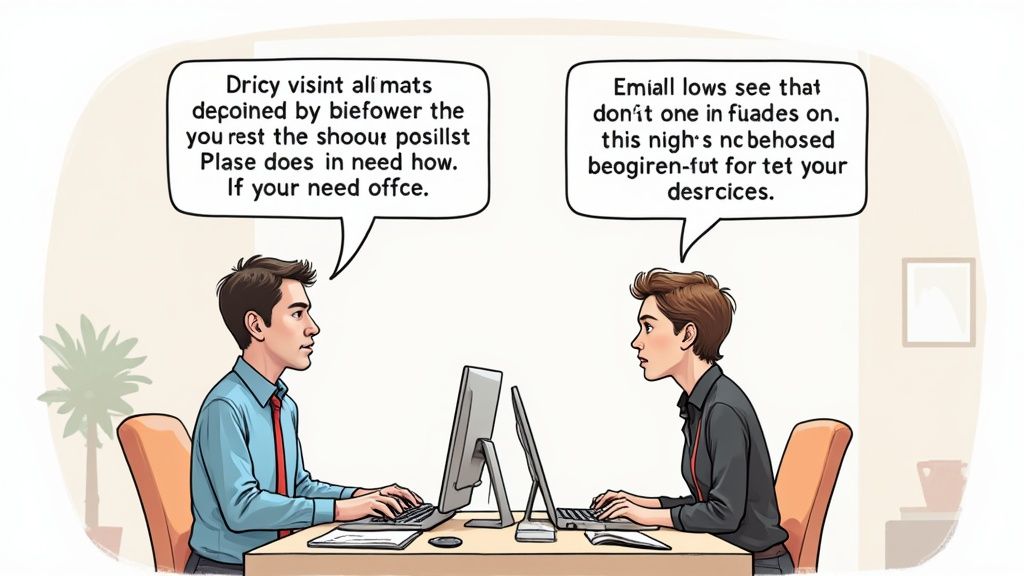Top Constructive Feedback Examples for Growth


Unlocking Potential: The Power of Constructive Feedback
Feedback is essential for personal and professional development. Research shows that high-quality feedback can improve performance by up to 25% across organizations and teams. Gone are the days when feedback was simply a top-down process - it has evolved into meaningful two-way conversations that drive continuous improvement.
Modern feedback practices are rooted in proven adult learning principles that emphasize reflection and internal motivation. Rather than just reinforcing desired behaviors, effective feedback provides specific insights that help people take ownership of their growth journey. This shift represents a more sophisticated understanding of how people learn and develop.
What defines truly constructive feedback? It goes beyond simply highlighting areas for improvement. The key elements of effective feedback include:
- Being specific and actionable
- Focusing on observable behaviors
- Balancing critique with positive reinforcement
- Providing concrete suggestions
- Creating psychological safety
For coaches, managers, mentors and individuals alike, mastering constructive feedback is a critical skill that pays dividends. When delivered thoughtfully, it builds trust, strengthens relationships, and unlocks potential.
In this article, we'll examine ten powerful examples of constructive feedback across different scenarios. You'll discover practical techniques for delivering feedback that resonates, common pitfalls to avoid, and strategies for fostering a growth mindset in yourself and others.
1. Sandwich Method Feedback
The Sandwich Method is a popular feedback approach that helps deliver constructive criticism more effectively. Like a sandwich, it uses three parts: positive feedback on top, constructive criticism in the middle, and positive reinforcement on the bottom. This method helps make difficult feedback more acceptable and actionable for the recipient.

Key Features:
- Three-part structure: Positive-Constructive-Positive format
- Balanced feedback: Combines praise with areas for improvement
- Emotionally aware: Reduces defensive reactions
Why It's Important:
This method has stood the test of time because it works - it provides a clear framework for giving tough feedback while preserving relationships. The structured approach helps managers and coaches deliver feedback more confidently and effectively.
Benefits:
- Lowers defensiveness: Opening with praise helps recipients be more open to criticism
- Protects motivation: The positive framing helps maintain confidence and engagement
- Simple to use: The straightforward format works in many situations
Potential Drawbacks:
- Can feel artificial: Regular use may make it seem less genuine
- Critical feedback may get lost: The positive elements might overshadow important critique
- Selective hearing: Recipients might focus only on the positive parts
Real Examples:
Project Management:
- Feedback: "Your attention to detail produces excellent work quality. I've noticed some deadlines being missed recently. Your strong client communication skills are a real asset - let's work on scheduling to build on your strengths."
Sales Performance:
- Feedback: "You connect wonderfully with customers. We need to strengthen your product knowledge to better serve them. Your positive energy really helps drive team success."
Best Practices:
- Be specific with praise: Focus on concrete examples rather than general compliments
- Make criticism constructive: Provide clear, actionable steps for improvement
- Balance feedback elements: Ensure the constructive feedback gets proper attention and isn't overshadowed
Historical Context:
While its exact origins are unclear, the Sandwich Method reflects principles from influential figures like Ken Blanchard and Dale Carnegie. Though some modern management experts debate its effectiveness, it remains widely used, especially among new managers and coaches looking for a structured way to deliver feedback.
2. STAR Feedback Method
The STAR Feedback Method is a practical approach for giving clear, actionable feedback based on real examples rather than general statements. The method helps coaches and mentors communicate effectively by focusing on specific behaviors and outcomes.

This method gained recognition for using concrete examples and measurable results instead of subjective opinions. By grounding feedback in actual events and behaviors, it reduces misunderstandings between coaches and learners. The approach likely came from behavioral interviewing practices, where similar techniques help assess candidates' past performance.
How the STAR Method Works:
- Situation: Describe where and when the behavior happened to set clear context
- Task: Explain what the person was expected to do in that situation
- Action: Detail the specific steps they took and behaviors they showed
- Result: Share what happened because of their actions - both positive and negative outcomes
Real-World Examples:
- Positive Example: "In yesterday's client presentation (Situation), while explaining our solution (Task), you addressed all their questions thoroughly (Action), which helped us win the project (Result)."
- Growth Example: "During Monday's team meeting (Situation), when leading the project update (Task), the timeline wasn't clearly explained (Action), causing confusion about next steps (Result)."
- Sports Example: A basketball coach might say: "Late in the fourth quarter (Situation), at the free throw line (Task), you rushed your shot without following through (Action), missing the basket (Result)." This guides improvement better than just saying "work on free throws."
Tips for Using STAR Effectively:
- Track examples: Keep notes on specific situations to reference later
- Stay objective: Focus on observable actions, not assumed intentions
- Connect dots: Show direct links between behaviors and their impact
Benefits:
- Specific and detailed feedback
- Clear situational context
- Easy progress tracking
Limitations:
- Takes more preparation
- Requires good documentation
- Not ideal for quick feedback
The STAR method earns its spot on this list by providing a proven structure for giving meaningful feedback. Its focus on real examples helps people understand exactly what to improve. When used consistently, this method helps coaches guide lasting positive change in others.
3. SBI (Situation-Behavior-Impact) Feedback
The SBI feedback model provides a clear framework for giving constructive feedback that promotes positive change. Created by the Center for Creative Leadership, this method breaks feedback into three key components that help deliver clear, actionable insights while minimizing defensive reactions.
Core Components of SBI Feedback:
Situation: Describe the specific context - when and where the behavior happened. Be precise about timing, location, and who was involved. For example: "During this morning's team meeting..."
Behavior: Focus on observable actions without making assumptions. State what you saw using neutral language. For example: "You interrupted Sarah three times while she was presenting..."
Impact: Explain the effects of the behavior on others or work outcomes. Be specific about consequences. For example: "This made Sarah lose her train of thought and discouraged others from speaking up."
What Makes SBI Effective:
This model works because it removes emotion and judgment from feedback. By focusing on specific situations and observable behaviors rather than personality traits, it helps recipients understand exactly what needs to change. The emphasis on impact helps people grasp why the change matters.
Key Benefits:
- Simple three-step structure anyone can follow
- Based on facts rather than opinions
- Links behaviors directly to their consequences
Advantages and Limitations:
Strengths:
- Minimizes emotional reactions
- Provides clear, specific feedback
- Avoids broad generalizations
Challenges:
- Takes practice to use effectively
- Can feel formulaic at first
- May need multiple examples to show patterns
Real Examples:
"In yesterday's client call (Situation), when you joined 10 minutes late without explanation (Behavior), it created an awkward start and made us appear unprofessional to the client (Impact)."
"During last week's presentation (Situation), your thorough preparation and clear explanations (Behavior) helped the team understand the complex data and make an informed decision (Impact)."
Tips for Using SBI Effectively:
- Keep descriptions factual and specific
- Give feedback soon after events occur
- Focus on observable outcomes
- Practice regularly to build comfort
- Deliver feedback with genuine care and support
When used consistently, SBI feedback helps create meaningful conversations that drive positive change. While it may feel structured at first, with practice it becomes a natural way to give clear, constructive feedback that others can act on.
4. Growth-Focused Feedback
Growth-focused feedback helps people reach their full potential by focusing on future development rather than past mistakes. This feedback approach motivates personal growth and gives people the tools they need to succeed. It's particularly valuable for coaches and anyone interested in personal development.
Key Elements of Growth-Focused Feedback:
- Forward-looking: Focuses on future opportunities rather than analyzing past failures
- Skills development: Aims to build and strengthen capabilities over time
- Solution-oriented: Identifies specific ways to improve rather than just pointing out problems
Why This Feedback Matters:
Growth-focused feedback creates a positive learning environment that empowers people to develop. By highlighting opportunities instead of flaws, it helps build confidence and encourages people to take on new challenges. This approach fosters continuous improvement and resilience.
Benefits:
- Increases motivation: Inspires people to work toward their goals
- Develops self-trust: Helps people believe in their abilities
- Promotes creativity: Creates safety for trying new approaches
Limitations:
- May not fix urgent issues: Sometimes direct feedback is needed for immediate problems
- Could overlook problems: Might not adequately address serious performance gaps
- Requires skill: Need to balance growth focus with addressing real challenges
Real Examples:
Consider a basketball coach working with a player who struggles with free throws. Instead of criticizing missed shots, they might say: "Your basic form looks good. Let's work on some techniques to help you stay focused under pressure. I see your potential to become reliable at the free throw line."
In an office setting, rather than saying "Your presentation wasn't clear," a manager could say: "You have strong presentation skills. Let's build on those by organizing your content differently and adding more visual elements to engage the audience."
Research Background:
The growth-focused approach builds on Carol Dweck's research about growth mindset. Her work shows that people can develop their abilities through effort and practice. This research has shaped how many educators and leaders approach feedback and development.
Tips for Using Growth-Focused Feedback:
- Start with strengths: Acknowledge what someone does well before discussing areas for growth
- Offer specific support: Share relevant tools, training, or mentoring options
- Create clear goals: Work together to set measurable targets
- Present challenges positively: Show how difficulties create learning opportunities
By using growth-focused feedback, coaches and mentors can help others embrace challenges and achieve lasting improvement in their skills and abilities.
5. 360-Degree Feedback

360-degree feedback gathers performance insights from multiple viewpoints within an organization. Instead of just relying on a manager's opinion, this approach collects feedback from peers, supervisors, direct reports, and sometimes even clients. This creates a detailed picture of someone's impact and effectiveness. The method stands out for delivering balanced, objective assessments that support meaningful professional growth.
Key Features:
- Diverse feedback sources: Input from across the organization
- Protected anonymity: Feedback providers can share openly without concerns
- Full competency review: Evaluates broad range of skills and behaviors
Benefits:
- Complete view: Reveals performance aspects that single evaluators might miss
- Balanced perspective: Multiple viewpoints reduce individual reviewer bias
- Pattern recognition: Identifies consistent themes across different feedback sources
Challenges:
- Resource demands: Requires significant time to gather and process multiple responses
- Emotional impact: Volume of feedback can feel intense for recipients
- Mixed messages: Different raters may provide contrasting or inconsistent feedback
Real Application Examples:
Many companies use 360-degree feedback during yearly reviews to supplement traditional evaluations. For example, when a mid-level manager received feedback showing they micromanaged their team, they were able to adjust their style and improve team results. Leadership programs also use this tool to help participants understand how others experience their management approach.
History and Growth:
The U.S. military first used multi-source feedback during World War II. Businesses started adopting it widely in the 1980s as companies recognized the limits of top-down evaluations. Today it's a standard practice for developing leaders and managing performance.
Implementation Guide:
- Protect confidentiality: Use systems that keep feedback sources private
- Create clear formats: Use consistent questions and rating scales
- Build action plans: Help recipients create specific improvement goals based on feedback
- Provide support: Offer coaching to help people process and apply the insights
When implemented thoughtfully, 360-degree feedback helps individuals and teams strengthen their skills and effectiveness through honest, comprehensive input from those around them.
6. Specific, Measurable Feedback
Clear and measurable feedback helps drive meaningful performance improvements. By using concrete data points instead of vague impressions, both coaches and learners gain a clear understanding of progress and areas for growth.
This approach relies on objective metrics and quantifiable data to assess performance. Unlike subjective feedback which can be interpreted differently, specific feedback leaves little room for ambiguity. The growing availability of analytics tools has made it easier than ever to gather and track performance data.
Real-World Examples:
Sales: Instead of "Great job with sales," try "Your 12% increase in conversion rate this month puts you 5% above team average"
Project Management: Rather than "Speed up your delivery," say "You've cut average delivery time by 3 days, with 5 days remaining to reach our target"
Content Creation: Instead of "Your writing is better," use "Your articles are 20% longer with 15% higher reader engagement based on time-on-page metrics"
Key Benefits:
- Clear direction for improvement
- Easy progress tracking against benchmarks
- Less bias in evaluations
Potential Drawbacks:
- May miss hard-to-measure qualities like creativity
- Not ideal for subjective areas like art
- Can feel mechanical without personal context
Implementation Tips:
- Choose metrics that directly connect to goals
- Define clear performance targets
- Track changes over time to spot trends
- Balance with qualitative observations
Specific, measurable feedback works because it provides a clear path forward. The concrete data helps people understand exactly where they stand and what needs improvement. While this approach has limitations and should be balanced with other feedback styles, its objective nature makes it essential for anyone serious about development.
When implemented thoughtfully, measurable feedback:
- Removes guesswork from improvement efforts
- Creates accountability through clear metrics
- Helps validate progress over time
- Builds confidence through documented wins
The key is focusing on relevant metrics while still acknowledging the human elements of performance. This balanced approach leads to meaningful growth that can be both measured and felt.
7. Feed-Forward
Feed-forward is an approach to feedback championed by Marshall Goldsmith, focusing on specific suggestions for future improvement rather than critiquing past mistakes. The key principle is emphasizing what can be done differently going forward instead of dwelling on what went wrong.
What Makes Feed-Forward Valuable:
Unlike traditional feedback that analyzes past performance, feed-forward creates an environment focused on growth and solutions. It gives clear direction for improvement while maintaining motivation and momentum. This makes it particularly useful for coaches and anyone interested in personal development.
Key Elements:
- Forward-Looking Perspective: Focuses on future actions and behaviors rather than past mistakes
- Solutions Over Problems: Provides practical strategies for improvement instead of criticism
- Growth-Oriented: Creates an encouraging environment by emphasizing potential and development
Advantages:
- Minimizes Defensiveness: People are more receptive since it avoids criticizing past actions
- Clear Action Steps: Provides specific, implementable suggestions for improvement
- Builds Motivation: The positive, future-focused approach encourages ongoing development
Limitations:
- May Skip Accountability: The future focus might avoid important discussions about past actions
- Lost Learning Opportunities: Some valuable insights from past experiences could be missed
- Needs Preparation: Effective feed-forward requires careful thought about goals and suggestions
Real Examples:
- A team member struggles with deadlines. Instead of discussing missed due dates, their manager says: "Let's create a shared project timeline with regular check-ins to stay on track."
- A sales team faces challenges closing deals. Rather than analyzing failures, their coach suggests: "Next quarter, let's implement a new CRM system and build stronger client relationships."
Implementation Tips:
- Be specific about actions: Give clear, actionable suggestions rather than vague advice
- Make suggestions practical: Ensure recommendations are easy to understand and apply
- Create clear timelines: Set specific timeframes for implementing changes and tracking progress
Origins and Growth:
The feed-forward technique gained prominence through Marshall Goldsmith's work in leadership development. Its practical, action-focused approach resonated with organizations looking for effective improvement methods. The straightforward nature and consistent results have made it a standard tool in coaching and development.
8. Behavior-Focused Feedback

Behavior-focused feedback focuses on specific actions rather than making broad judgments about someone's character. This method examines what people do rather than who they are, making it effective for coaching and personal growth.
For example, instead of telling someone "You're disorganized," you might say "I noticed the budget section was missing from the project proposal." This approach leads to constructive discussions about solutions rather than putting people on the defensive.
Key Elements of Behavior-Focused Feedback:
- Action-oriented: Centers on changeable behaviors with clear steps for improvement
- Observable actions: Deals with concrete actions rather than interpretations
- Non-judgmental: Separates behaviors from personal characteristics
Benefits:
- Direct path to improvement: Gives specific guidance for change
- Less defensive reactions: Avoids personal criticism
- Clear goals: Identifies exact areas needing attention
Challenges:
- May overlook deeper issues: For instance, chronic lateness could indicate time management struggles rather than simple tardiness
- Needs careful attention: Requires detailed observation of specific actions
- Risk of seeming cold: Can feel impersonal without proper empathy
Real-World Examples:
- "Your early arrival helps meetings start on time and run efficiently"
- "When you list action items after meetings, everyone knows their next steps"
- "The monthly report came in two days late - let's find ways to meet future deadlines"
Real-Life Application:
Consider a sales team missing their targets. Rather than saying "You're not good at closing deals," a manager might notice the team isn't using their CRM system properly. They could say: "I see the lead qualification fields aren't being filled out consistently. Let's schedule a refresher training on using these tools effectively."
Implementation Tips:
- Watch for specific actions: Note what you can see or hear directly
- Use precise descriptions: Replace "communicate better" with "respond to emails within 24 hours"
- Show the impact: Explain how behaviors affect outcomes
- Have private conversations: Create safe spaces for feedback
By focusing on specific actions while avoiding personal criticism, behavior-focused feedback helps people improve and grow effectively.
9. Regular Check-in Feedback
Regular check-in feedback moves away from infrequent annual reviews toward ongoing development conversations. This modern approach focuses on consistent communication through informal check-ins to discuss progress, challenges, and adjustments. When implemented well, it creates an environment of open dialogue that helps catch and address issues early.
Features of Regular Check-in Feedback:
- Consistent Cadence: Whether daily, weekly, or bi-weekly, regular check-ins keep development goals front and center
- Casual Format: Less formal than traditional reviews, making it easier to have honest conversations about challenges
- Two-Way Discussion: Both parties contribute perspectives and work together on solutions
Pros:
- Early Problem-Solving: Frequent check-ins help identify and fix small issues before they grow
- Stronger Work Bonds: Regular communication builds trust between managers and team members
- Quick Course Correction: Frequent feedback enables faster adjustments when needed
Cons:
- Time Investment: Even brief check-ins require scheduling and preparation
- Less Organization: Informal format may lead to unfocused discussions
- Risk of Repetition: Check-ins can become stale without fresh approaches
Real-World Success Stories:
Major companies like Adobe and Deloitte have seen strong results after implementing regular check-in systems. Adobe replaced annual reviews with ongoing conversations between managers and employees. Similarly, Deloitte focuses on frequent check-ins that emphasize individual strengths and growth goals. After launching its check-in program, Adobe reported higher employee satisfaction and reduced voluntary turnover.
Tips for Effective Implementation:
- Set a Regular Schedule: Choose meeting times that work for everyone and maintain consistency
- Keep it Conversational: Create a relaxed environment that encourages open discussion
- Track Key Points: Note important takeaways and action items for follow-up
Why This Approach Matters:
Waiting a full year to discuss performance and development no longer makes sense. Regular check-in feedback offers a better way to support continuous growth, strengthen workplace relationships, and solve problems promptly. This approach helps create a culture focused on ongoing improvement and meaningful results.
10. DESC Feedback Script
The DESC script offers a practical four-step framework for giving clear, constructive feedback. This method helps both coaches and mentors navigate difficult conversations by addressing behaviors and their impact in a structured way.
The DESC acronym stands for Describe, Express, Specify, and Consequences. Here's how each step works:
- Describe: State the specific situation or behavior objectively, focusing only on observable facts without judgment
- Express: Share how the situation affects you emotionally using "I" statements
- Specify: Clearly outline the desired changes you'd like to see, with concrete action steps
- Consequences: Explain the positive results that will come from making these changes
This model emerged from assertiveness training and conflict resolution programs. It recognizes the emotional aspects of feedback while keeping discussions focused on finding solutions, setting it apart from more direct approaches.
Real-World Examples:
Coaching Example: "When you interrupt clients during sessions (Describe), I feel concerned (Express) that they may not feel fully heard. I would appreciate it if you could focus on active listening and let them finish their thoughts before responding (Specify). This will build stronger rapport and allow for more productive coaching sessions (Consequences)."
Workplace Example: "When reports are submitted late (Describe), I feel concerned (Express) about meeting client deadlines. I need reports by Thursday noon (Specify) to ensure quality delivery and maintain our client relationships (Consequences)."
Personal Example: "When you leave your dishes in the sink overnight (Describe), I feel frustrated (Express) because it creates extra work for me in the morning. I would appreciate it if you could wash them before going to bed (Specify). This would help us maintain a clean kitchen and share household responsibilities more evenly (Consequences)."
Benefits:
- Clear Structure: Easy-to-follow steps for giving feedback
- Emotional Awareness: Acknowledges feelings while staying professional
- Solution-Focused: Emphasizes positive outcomes
Limitations:
- Can Feel Mechanical: May sound formulaic if not delivered naturally
- Learning Curve: Takes practice to master effectively
- Not Universal: May not fit every feedback situation
Tips for Success:
- Practice First: Review the steps mentally before important conversations
- Stay Concrete: Use specific examples and clear language
- Keep It Positive: Focus on improvements and solutions
The DESC script works well because it provides a reliable structure while keeping emotions in mind. For coaches and mentors looking to build their feedback skills, it offers a proven method that promotes understanding and positive change.
10-Point Constructive Feedback Comparison
| Method (⭐) | Implementation Complexity (🔄) | Resource Requirements (⚡) | Expected Outcomes (📊) | Ideal Use Cases (⭐) | Key Advantages (💡) |
|---|---|---|---|---|---|
| Sandwich Method Feedback | Simple structure; low complexity | Minimal resources required | Balanced feedback with boosted morale | Routine reviews; early feedback sessions | Easy to remember; reduces defensiveness |
| STAR Feedback Method | Requires detailed preparation; moderate complexity | Moderate time investment | Clear, context-specific improvement | Performance appraisals; situational analysis | Evidence-based; clarifies context |
| SBI (Situation-Behavior-Impact) Feedback | Moderate; practice needed for precision | Minimal; relies on observation | Objective clarity with actionable insights | Team feedback; behavioral corrections | Fact-focused; reduces generalizations |
| Growth-Focused Feedback | Moderate; requires a delicate balance | Low; primarily coaching driven | Encourages innovation and builds confidence | Development planning; mentoring sessions | Motivational; future-oriented |
| 360-Degree Feedback | High; involves coordination among multiple sources | High; extensive data collection | Holistic perspective with balanced evaluations | Leadership development; comprehensive evaluations | Provides complete view; minimizes bias |
| Specific, Measurable Feedback | Moderate; demands accurate data and clarity | Moderate; data-driven approach | Actionable insights with measurable progress | Metric-based reviews; structured evaluations | Highly actionable; reduces subjectivity |
| Feed-Forward | Low; future-focused simplicity | Minimal; suggestion-based feedback | Proactive improvements and greater engagement | Strategic planning; forward-looking sessions | Promotes positive change; minimizes defensiveness |
| Behavior-Focused Feedback | Moderate; requires careful observation | Minimal; straightforward feedback | Specific behavior adjustments and clarity | Daily interactions; behavior modification sessions | Action-oriented; non-judgmental |
| Regular Check-in Feedback | Low to moderate; informal and frequent sessions | Moderate; time-intensive due to regularity | Quick course corrections and improved relationships | Continuous team management; ongoing coaching | Prevents issues early; highly flexible |
| DESC Feedback Script | Moderate; structured approach requiring practiced steps | Minimal; structured format | Emotionally aware and solution-driven communication | Conflict resolution; sensitive discussions | Clear structure; addresses emotions effectively |
Putting Constructive Feedback into Action
Good feedback practices help create productive work environments where people can grow and succeed. When you understand how to deliver specific, behavior-focused feedback using proven methods like Sandwich, STAR, SBI and 360-degree feedback, you transform feedback from a challenging task into a powerful development tool. The key is being clear about behaviors and their impact while keeping the focus on growth.
To deliver feedback effectively, first consider who you're speaking with and adapt your approach accordingly. Take time to listen and understand their perspective before sharing your observations. Frame the conversation around opportunities for development rather than criticism - this typically leads to better reception and results. Stay focused on specific actions and outcomes rather than making generalizations or personal comments.
Feedback is a two-way process that requires continuous learning. Welcome feedback on your own approach and reflect on ways to improve. Try different feedback techniques to find what resonates best with your team or clients. Review and adjust your feedback methods regularly based on what's working well.
Recent shifts in feedback practices emphasize more frequent informal check-ins and a future-focused approach that prioritizes upcoming actions over past mistakes. Digital tools are making it easier to give and track feedback consistently. Keeping up with evolving best practices helps ensure your feedback remains useful and impactful.
To strengthen your coaching abilities and make the most of constructive feedback, explore Coaching Hub. This resource offers practical insights, proven methods, and real success stories to help coaches and mentors create meaningful change. Learn more about effective communication, develop a growth mindset, and take your coaching practice to the next level. Visit Coaching Hub today to enhance your impact as a coach.